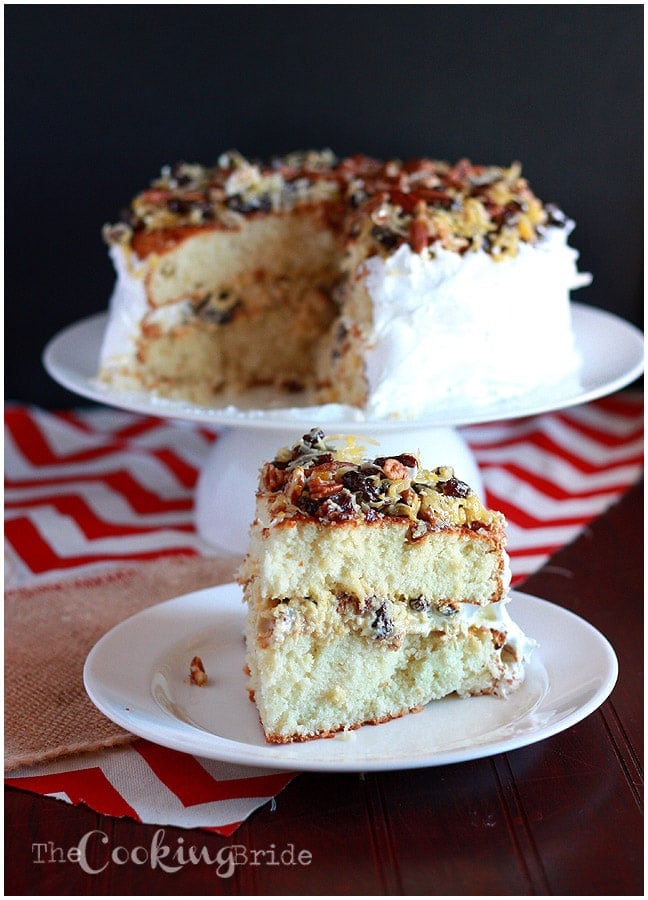Amalgamation Cake
A forgotten Southern classic, Amalgamation cake is filled with raisins and coconut, iced with homemade frosting and garnished with more coconut and raisins.

Last year, I was asked to write an article for eat.drink.MISSISSIPPI about the Amalgamation Cake. Never heard of it? Neither had I.
I had no idea that this grand dame of Southern desserts would prove to be so elusive and mysterious. Here in the South, a family recipe is almost as treasured as the family Bible. Often, there is no recipe. Just a technique passed down generation to generation. If a recipe does exist, sometimes it is nothing more than a hastily written list of ingredients and vague instructions. Many recipes are closely-guarded secrets that certain members of the family are sworn by blood to protect.
The Amalgamation Cake is one such recipe. I began my investigation by asking friends, family members, and even perfect strangers if they knew our cake in question. Half of those I polled had never heard of the dessert. The other half all told similar stories. Each had a family member – father, brother, uncle, grandfather – who considered Amalgamation Cake to be their favorite dessert. And each had a mother, sister, aunt, grandmother who made it every year – usually around the holidays. The origin is unknown. States all across the Southeast each claim her as their own.

The Search for the Perfect Amalgamation Cake Recipe
When I began my research for a tried-and-true Amalgamation Cake recipe, I discovered dozens and dozens of recipes, each one varying widely. Ingredients ranged from five eggs to ten. Jam or no jam for the filling. Some recipes included detailed instructions while others were so vague they didn’t even list a baking time or temperature. One thing they all agree on – freshly grated coconut was best.
I finally settled on this recipe. It seemed to have all the necessary ingredients and step-by-step instructions. The more involved I got in the process, the more I understood why this decadent dessert only makes an appearance once a year. It is a labor of love to create, requiring many steps and just as many mixing bowls.
How to Make Amalgamation Cake
Merriam-Webster defines amalgamation as, “to unite two or more things into one thing.” I can only assume the cake got its name from the process required to combine raisins, coconut, and a whole lotta butter and eggs.
Bake the Cake Layers
Before you get started, set out two sticks of unsalted butter out to come to room temperature.
Step one. Heat the oven to 350 degrees. Grease two 9-by-2-inch round cake pans, then lightly sprinkle them with flour to prevent sticking. Set the pans aside for now.
Step two. Place the softened butter in the bowl of an electric mixer. Cream on medium-low speed and gradually add two cups of granulated sugar. Continue beating until the mixture turns a pale yellow.
Step three. In a medium mixing bowl, sift together 3 cups of flour, two teaspoons of baking powder and ¼ teaspoon of salt. With the mixer on low, add about a third of the dry ingredients to the creamed butter. Follow with half of the milk. Repeat the steps, ending with the remaining dry ingredients.
Continue to mix, scraping down the sides of the bowl as needed, until ingredients are thoroughly combined.
Step four. In another clean mixing bowl, beat the egg whites until stiff peaks form. This post explains what stiff peaks are and how to create them. Take one cup of the beaten whites and whisk it into the batter.
Gently fold the remaining whites into the batter. Folding means we are gently mixing the eggs whiles into the batter by hand rather than beating it with a mixer to prevent the fluffy egg whites from going flat.
Step five. Divide the batter between the two prepared pans. Bake about 30-40 minutes until the tops are pale golden brown and a toothpick inserted into the center comes clean. Remove the cake pans to a rack to cool slightly. Then invert the cake layers onto a rack to cool completely.
Make the Filling:
Our two cake layers are separated by a creamy filling chocked full of raisins, coconuts and pecans.
Step one. Before you get started, separate five eggs. Set aside two of the egg whites – we will use them later. Leave the yolks setting out for about 30 minutes until they come to room temperature. Then combine the egg yolks with 1 ½ cups of granulated sugar and one stick of unsalted butter in a medium, heavy saucepan. Bring the mixture to a simmer over medium heat.
Step two. Cook, stirring constantly, until the sugar is completely dissolved, and the mixture is thick. This will take about 10 minutes.
Step three. Remove the pan from the heat and add one cup of raisins, one cup of sweetened grated coconut and one cup of chopped pecans. Set mixture aside but keep it warm.
Make the Frosting:
Step one. In a small, heavy saucepan, combine 2 cups of granulated sugar with ¾ cup water and one teaspoon of cream of cream of tartar Heat over medium heat, stirring occasionally, until sugar has dissolved. Increase the heat to a boil, but do not stir anymore.
Step two. Boil, washing down sides of pan with a pastry brush dipped in cold water from time to time to prevent the sugar from crystallizing. Keep doing this until a candy thermometer registers 240 degrees. This should take about 5 minutes. Remove the sugar syrup from the heat when the temperature reaches 240 degrees.
Step three. Meanwhile, whisk those two room temperature egg whites we just saved on medium speed for about 2 ½ minutes until soft peaks form.
Step four. With the mixer running on medium-low speed, pour the syrup in a steady stream down the side (to avoid splattering) of the bowl containing the egg white mixture. Beat the frosting on medium speed until cool, about 5 to 10 minutes. The frosting should be thick and shiny.
Assembling Amalgamation Cake
To assemble the cake, place one of the cooled cake layers on plate. I like to put a few strips of waxed paper down first to catch any drips. Use a cake leveler to trim a little off the top to give you a nice even layer.
Spread the top of the cake layer with half the fruit filling. Top with the second layer. Ice only the sides of the cake with the reserved boiled icing. Spread the remaining fruit filling over the top of the cake.
I have to admit, once my creation was complete, it’s an impressive dessert. Tall, regal, sugary sweet and flanked by sweet potato casserole or your Grandmother’s recipe for cornbread dressing, this lady would look right at home on a Christmas dinner table.

You Might Also Like:

Amalgamation Cake
Ingredients
For the cake:
- 2 sticks (1 cup) unsalted butter, room temperature
- 2 cups granulated sugar
- 3 cups all-purpose flour
- 2 teaspoons baking powder
- ¼ teaspoon salt
- 1 cup whole milk room temperature
- 5 egg whites room temperature
For the fruit filling:
- 5 egg yolks room temperature
- 1 ½ cups granulated sugar
- 1 stick (½ cup) unsalted butter
- 1 cup raisins
- 1 cup sweetened grated coconut
- 1 cup chopped pecans
For the boiled white frosting:
- 2 cups granulated sugar
- ¾ cup water
- 1 teaspoon cream of tartar
- 2 egg whites room temperature
Instructions
For the cake:
- Heat the oven to 350 degrees. Prepare two 9-by-2-inch round cake pans. Set aside.
- Place butter in the bowl of an electric mixer. Cream on medium-low speed and gradually add the sugar. Continue mixing until pale yellow.
- In a medium mixing bowl, sift together 3 cups flour, baking powder and salt. With the mixer on low, add about a third of the dry ingredients. Follow with half of the milk. Repeat the steps, ending with the remaining dry ingredients. Continue to mix, scraping down the sides of the bowl as needed, until ingredients are thoroughly combined.
- In another clean mixing bowl, beat the egg whites until stiff peaks form, about 3 to 5 minutes. Take a cup of the beaten whites and whisk it into the batter. Then gently fold the remaining whites into the batter.
- Divide the batter between the prepared pans. Bake until the tops are pale golden and a toothpick inserted into the center comes clean, 35 to 40 minutes. Remove to a rack to cool slightly. Invert the cake layers onto a rack to cool completely.
For the filling:
- Combine the egg yolks, sugar and butter in a medium, heavy saucepan over medium heat.
- Cook, stirring constantly, until the sugar is completely dissolved and the mixture is thick, about 10 minutes.
- Remove from the heat and add the raisins, coconut and pecans. Set mixture aside and keep warm.
For the frosting:
- In a small, heavy saucepan, combine the sugar, water and cream of tartar. Heat over medium heat, stirring occasionally, until sugar has dissolved. Increase heat to a boil. Do not stir anymore.
- Boil, washing down sides of pan with a pastry brush dipped in cold water from time to time to prevent the sugar from crystallizing, until a candy thermometer registers 240 degrees, about 5 minutes. Remove the sugar syrup from the heat when the temperature reaches 240 degrees.
- Meanwhile, whisk the egg whites on medium speed until soft peaks form, about 2 ½ minutes.
- Pour the syrup in a steady stream down the side (to avoid splattering) of the bowl containing the egg white mixture, with the mixer on medium-low speed. Beat frosting on medium speed until cool, 5 to 10 minutes. The frosting should be thick and shiny.
- To assemble the cake, place one of the cooled cake layers on plate. You may need to trim the top of the cake to ensure you have a flat surface. Spread the top with half the fruit filling.
- Top with the second layer. Spread the remaining fruit filling over the top of the cake only. Ice the sides of the cake with the reserved boiled icing.






Thank you for sharing that memory, Becki!
My grandmother used to make this cake for church outings after Sunday service when I was young miss those days